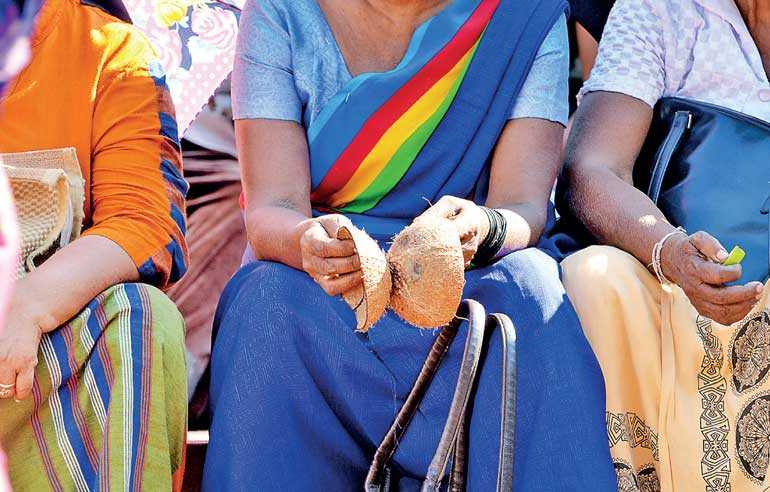Tuesday Jan 06, 2026
Tuesday Jan 06, 2026
Wednesday, 10 October 2018 00:00 - - {{hitsCtrl.values.hits}}

Women activists are heterogeneous. They are everything from garment factory workers and domestic workers, who advocate for workers’ rights, to social workers and teachers who go beyond their occupational duties, to affluent women who leverage their privilege to make male elites listen
– Pic by Shehan Gunasekara

Sri Lankan media does not have the best track record of covering issues related to women. Sometimes their mistakes are rather explicit – like publishing identifying details about survivors of sexual violence, publishing images that infringe on the privacy and dignity of individuals, etc. Consistently, though, the media undermines women in more subtle ways, using a whole range of communication practices.
Some might argue that these instances reflect subconscious biases determined by the society we live in but this is a far too easy and false route to take. We craft our society, and communication – as a basic tool of understanding one another – lies at the heart of it.
When do you decide to listen to a woman?
Women’s opinions are rarely sought out. It is all too common to see ‘expert panels’ consisting entirely of men, even when it comes to issues largely affecting women, such as discussions on the informal economy, microfinance, migrant work, or post-war development. Even regarding matters that women logically ought to represent, such as sexual and reproductive health rights, men still hold the mic and the political power.
A case in point is the infamous photograph of male clergy laughing with male politicians at a roundtable, deciding amongst themselves against granting women access to safe medical services, such as abortion. Not only did they have complete political control over the issue, but they were also the ones media sought out in their coverage.
Where in media were the voices of women who faced the difficult decision to terminate pregnancies, or who had survived botched illegal procedures, or the families facing the loss of women to botched procedures. Where were the voices of the massive network of women activists working on the ground on these very issues?
Recent coverage of female genital mutilation (FGM) in Sri Lanka also caught our Eye. In a lengthy feature article, a widely-read daily paper covered the perspective of several conservative Muslim groups who supported the medicalisation of FGM. What was surprising and unusual was that it quoted the personal voice of a woman representative. When exactly is it then that media (and society) decides to listen to women? It seems, in this instance, to only amplify women’s voices when it serves to confirm or reinforce conservative views.
This is even more so evident when you try to look for the voices of women activists fighting against FGM: mainstream newspapers rarely foreground them. In this case it must be noted that the same newspaper published a few op-ed responses by women. However, it is highly unlikely that the paper sought out these rebuttals, but rather, individuals and groups who felt the need to respond sent them in. Therefore, this does not necessarily reflect willingness to centre women’s voices and opinions.
More often than not, the opinions of activists appear in articles reprinted from international media sources such as Reuters or Al Jazeera. These international sources and journalists make the effort to seek out and speak to women activists on the ground to understand the situation – why is it that local journalists do not?
Additionally, even while women in general have a difficult time occupying space in Sri Lankan media, it is important to note that their gender is not the only thing that mediates their access, but also the privileges that come with being of a certain class, ethnicity, and so on. For women who do no hold these privileges, finding space for their voices becomes even more difficult.
How do you portray women?
When women do find their way into media, there is then the additional hurdle of how media portrays them.
Many will be familiar with the construct of the ‘feminist auntie’. She comes from Colombo 7, is born to a wealthy family or married to a wealthy man, and with the free time on her hands, she fights for ‘women’s rights’. These images do not come out of the blue: they are conscientiously crafted to undermine the legitimacy, and ignore the diversity, of women’s rights advocacy. The media again has a role to play in whether they prolong this image or actually portray the reality of women’s struggles and their activism.
Some articles on the alcohol ban earlier this year also display the potency of language in crafting the image of the ‘woman’ activist behind a story. A group of women professionals banded together to file a Fundamental Rights petition against the ban, citing discrimination on the basis of sex, which is unconstitutional as per Article 12(2). Note that this was not the only petition against the ban – several others were also filed, some by majority male petitioners. However, it was the petition filed by these women that the media chose to highlight.
One noteworthy article described the women as ‘nit-picking’, ‘nagging’, ‘bemoaning’, and ‘lamenting’. This is not innocuous language and nor was it utilised unconsciously. Rather, this language is heavily gendered and plays to the stereotype of a whiny woman who is just complaining, thereby undercutting the legitimacy of this legal challenge to discrimination.
It becomes easy to trick the public into thinking of women activists this way when they rarely see any other images. However, women activists are heterogeneous. They are everything from garment factory workers and domestic workers, who advocate for workers’ rights, to social workers and teachers who go beyond their occupational duties, to affluent women who leverage their privilege to make male elites listen.
There is no lack of organisations, activists, movements, collectives, and research dedicated to issues affecting women in Sri Lanka, so it would not be difficult to create a sustained media presence, which reflects the nuances of Sri Lankan women’s struggles and advocacy. And yet, when the public reads their paper, watches television, or listens to the radio, this is often missing. The predominant image is one that demeans women.
Amplify women’s voices
Women in Sri Lanka are constantly working to ensure their rights are recognised. They are present in every avenue: education, nutrition, health, welfare, economy, labour, political representation, etc. Media has the power to choose whose voices are heard, what topics receive sustained reportage, and how these issues are portrayed.
When, for example, we are discussing issues with nutrition during pregnancy, there is no end to quotes from the male health minister. Why not interview the women advocates who are directly involved instead? Or how about the midwives, women’s development officers at the local government level, or women who have relied on State-provided nutritional care?
When new challenges to migrant domestic workers arise, such as the recent Family Background Report, why not speak to activists who have been involved in this field for decades or domestic workers themselves, rather than political figures who have held portfolios for less than one term?
There has never been any need to ‘give women a voice’. We have always been speaking, activating, agitating. There only remains the need to actually listen to us.
(The Cat’s Eye column is written by an independent collective of feminists, offering an alternative feminist gaze on current affairs in Sri Lanka and beyond.)